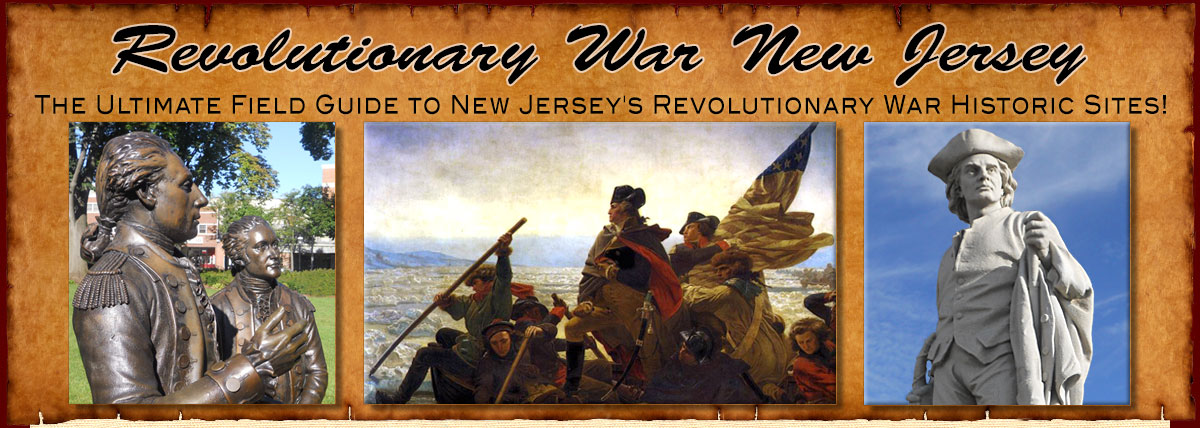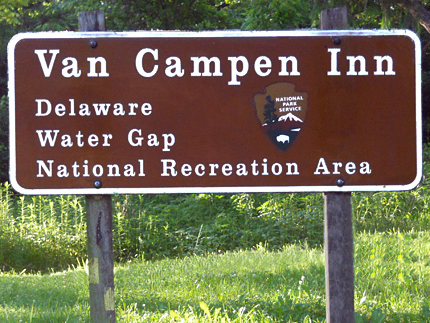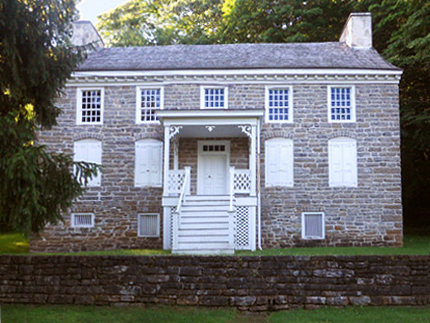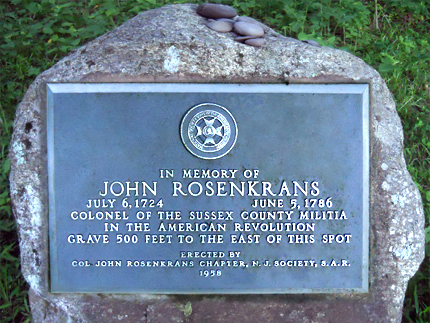




Van Campen Inn
Colonel John Rosenkrans Boulder Monument
Military Trail
All located on Old Mine Road
Click Here for Map / Directions
For information about visiting the Van Campen Inn, see these websites:
Walpack Historical Society
Delaware Water Gap section of the National Park Service
A Guide to Military Trail brochure is available as a PDF at the National Park Service website
The Van Campen Inn was built circa 1750 and was purchased in 1754 by Isaac Van Campen. [1] In 1776, Isaac Van Campen served as a delegate to one session of the Provincial Congress of New Jersey. [2] The Provincial Congress was the governing body of New Jersey during the early period of the Revolutionary War as the transition was made from British colony to a state of the United States of America.
The 1,000-acre plantation property of John Rosenkrans was located next to the Van Campen Inn. John Rosenkrans served as a captain and then a colonel in the Third Battalion of the Sussex County Militia. The boulder monument to Rosenkrans shown above stands about a half mile northeast of Van Campen Inn. Rosenkrans is buried in the small Shapanack Dutch Reformed Church Cemetery, 500 feet from the monument, but his gravesite is not marked. [3]
Military Trail is a one-mile hiking trail beginning on Old Mine Road about 200 yards from Van Campen Inn. It is part of what was once a 60-mile supply road that originated during the French and Indian War as a supply route from Sussex County to Elizabeth. A fort called Shapanack Fort (also known as Fort Johns), which had been built during the French and Indian War, was located along Military Trail. The trail was also later used during the Revolutionary War. [4]
In December 1776, General Horatio Gates and several regiments encamped at Van Campen Inn for a night. Gates wrote a letter to General George Washington from Van Campen Inn, mentioning that "There was a deep Snow last night at this place; it is now mild, and promises Rain." [5] Gates and his troops were en route to what would become the First Battle of Trenton. However, although Gates's troops took part in the Battle of Trenton, Gates himself did not, on account of illness. [6]
General Casimir Pulaski and his cavalry troops encamped here in November 1778. [7] Pulaski was a Polish officer who came to America to fight on the American side in the Revolutionary War. He is remembered as the "Father of American Cavalry." There are four statues of General Pulaski in New Jersey, located in Garfield, Paterson, Pennsauken, and Wallington.

1. ^ Old Mine Road historic marker, place by the Chinkchewunska Chapter D.A.R.
2. ^Minutes of the Provincial Congress and the Council of Safety of the State of New Jersey (Trenton: Naar, Day & Naar, 1879) page 445
Available to be read at Google Books here3. ^ Plaque erected by the Col. John Rosenkrans Chapter, New Jersey Society, Sons of the American Revolution 1958.
• William S. Stryker, Official Register of the Officers and Men of New Jersey in the Revolutionary War (Trenton: Wm. T. Nicholson & Co., 1872) Pages 348 and 353
Available to be read at the Internet Archive here• The Daughters of the American Revolution Genealogical Research System, where John Rosenkrans is Ancestor # A098237
4. ^ "Guide to Military Trail" National Park Service brochure.
Available as a PDF on the National Park Service website here.5. ^ “To George Washington from Major General Horatio Gates, 12 December 1776,” Founders Online, National Archives, last modified July 12, 2016, http://founders.archives.gov/documents/Washington/03-07-02-0244. [Original source: The Papers of George Washington, Revolutionary War Series, vol. 7, 21 October 1776–5 January 1777, ed. Philander D. Chase. Charlottesville: University Press of Virginia, 1997, pp. 308–309.]
▸ Gates's letter is marked as being sent from "Van Kemp’s 15 Miles from Sussex Court House," which is apparently Van Campen's.6. ^“From George Washington to Major General Horatio Gates, 23 December 1776,” Founders Online, National Archives, last modified July 12, 2016, http://founders.archives.gov/documents/Washington/03-07-02-0326. [Original source: The Papers of George Washington, Revolutionary War Series, vol. 7, 21 October 1776–5 January 1777, ed. Philander D. Chase. Charlottesville: University Press of Virginia, 1997, p. 418.]
7. ^ “From George Washington to Brigadier General Casimir Pulaski, 10 November 1778,” Founders Online, National Archives, last modified July 12, 2016, http://founders.archives.gov/documents/Washington/03-18-02-0096. [Original source: The Papers of George Washington, Revolutionary War Series, vol. 18, 1 November 1778 – 14 January 1779, ed. Edward G. Lengel. Charlottesville: University of Virginia Press, 2008, pp. 88–89.]
▸ Washington instructs Pulaski to go to this area (Minisink) and mentions a "Mr Van Camp," presumably Isaac Van Campen.“To George Washington from Brigadier General Casimir Pulaski, 15 November 1778,” Founders Online, National Archives, last modified July 12, 2016, http://founders.archives.gov/documents/Washington/03-18-02-0157. [Original source: The Papers of George Washington, Revolutionary War Series, vol. 18, 1 November 1778 – 14 January 1779, ed. Edward G. Lengel. Charlottesville: University of Virginia Press, 2008, pp. 157–158.]